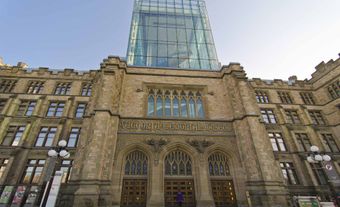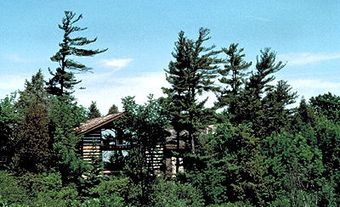The McCord Stewart Museum is one of the few museums in Canada dedicated to the study of social history. Initially opened as the McCord National Museum in 1921, it closed to the public during the Great Depression. It reopened in McGill University’s old Student Union Building in downtown Montreal in 1971. It merged with the Stewart Museum in 2013 and absorbed the Fashion Museum in 2018. The McCord Stewart Museum was originally created to house the extensive collection of Canadiana amassed by David Ross McCord. The museum holds an estimated 2.1 million items, including objects, images and manuscripts.

Background and Origins
David Ross McCord (born 18 March 1844 in Montreal, QC; died 12 April 1930 in Guelph, ON) was a wealthy Montreal lawyer and philanthropist. He was a descendent of two wealthy and prominent 19th-century Quebec families: the Ross and McCord families. McCord collected various objects and artifacts relating to Canadian history — specifically concerning Indigenous peoples and the anglophone community of Montreal. Between 1880 and 1920, McCord accumulated a collection of between 15,000 and 18,000 artifacts.
McCord began adding to his family’s already formidable collection as early as 1878. He began looking for a permanent home for his collection as early as 1903. Unable to find a suitable location, he kept his collection in his home at the corner of Côte des Neiges and Cedar Avenue, which was dubbed Temple Grove.
McCord was driven by a belief that a better understanding of Canadian history would help cement an independent Canadian identity. This idea was shared by other Canadian imperialists at the time. McCord also wanted his museum to be a place where Canada’s history would be preserved and celebrated.
With the assistance of William D. Lighthall (a non-academic historian who published the book Montreal After Two Hundred and Fifty Years) and librarian Charles Henry Gould, McCord persuaded McGill University to accept his collection as a donation in 1919. The university exhibited it in the former home of Montreal merchant Jesse Joseph. The new museum, initially named the McCord National Museum, opened to the public on 13 October 1921.

Early Years
The McCord Museum was initially conceived as an extension of McGill University — a place like the university library, where students could continue their research. William D. Lighthall thought that students returning with samples from archaeological digs would compare their findings with the exhibits in the museum.
David McCord maintained his position as curator of the museum until his death in 1930. But he was too ill in his later years to be involved in the museum’s day-to-day operations. The museum’s exhibits remained essentially unchanged throughout the decade. Mary Dudley Muir served as assistant curator. She was primarily responsible for the museum until 1928, when she was replaced by Dorothy Warren. Warren was responsible for some early efforts to promote the museum to the public. She also undertook a careful cataloguing of the museum’s collections.
Closure
McGill University increased the number of temporary exhibits geared toward the public. But it ultimately decided to close the museum during the Great Depression as a cost-saving measure. This was meant to be temporary, but the museum remained closed until 1971.
Business During Closure
During the more than 30 years the museum was closed to the public, objects from the McCord collection continued to be used to mount exhibitions on Canadian history. It often used space in the Redpath Museum or the Redpath Library at McGill University’s downtown campus. During the 1950s, temporary public exhibits were mounted for local high school students.
Two important individuals — Gordon Lowther and Isabel Barclay Dobell — were hired in the mid-1950s. They helped breathe new life into the institution, namely by cultivating research, collections and the preservation of the artifacts. It was also in the 1950s that the McCord Museum received the archives of William Notman & Sons, one of Canada’s most important and prolific photography studios. The Notman Collection provides an unparalleled look at Canada from the mid-19th century to the early 20th century.

1971 Reopening
With the Jesse Joseph house set to be demolished, McGill University moved the McCord Museum into the former mansion of businessman Archibald Arthur Hodgson, who donated his home to the university. The McCord Museum moved in 1954 and managed to have a public exhibition space open by 1960. But the Hodgson House was far too small for what the museum needed. McGill decided as early as 1964 that the McCord would be better suited in the larger space provided by the old McGill Student Union building (an architecturally and historically significant building in its own right, designed by noted architect Percy Erskine Nobbs). It was largely thanks to the tireless efforts of Isabel Dobell that McGill agreed to relocate the McCord and open it to the public. The McCord Museum officially opened at its new location in 1971. With the exception of the COVID-19 pandemic, it has been open to the public ever since.
1992 Expansion
The McCord Museum had been managed by McGill University for over 60 years when, in 1987, it received a generous donation from the J.W. McConnell Family Foundation. This allowed the museum to become fully independent of the university and to undergo a massive expansion project. The expansion was completed in 1992, the same year as the 350th anniversary of the founding of Montreal. In addition, the McCord recovered its entire collection.

Merger with Stewart Museum
In 2013, the McCord Museum merged with the Stewart Museum. Dedicated to the history of colonial Montreal, the Stewart Museum had been located in the Fort de l'Île Sainte-Hélène area since 1955. The two museums continued to operate publicly as before, but their administrations were consolidated and their collections began to be integrated. The Stewart Museum was ultimately closed to the public in February 2021.
Collections
In more recent years, the McCord has increasingly focused on social history and the history of Montreal. It has also taken important steps toward developing research tools, collections and exhibits focused on Indigenous history and culture. In 2018, the McCord merged with the Fashion Museum, which added 7,000 garments, textiles and accessories to its collection. In 2019, the McCord launched EncycloFashionQC, the first online encyclopedia devoted to Quebec fashion.
The McCord’s collections:
- Archives: Roughly 340 linear metres worth of archival materials, including maps, plans, diaries, correspondence, menus, deeds and advertisements.
- Costume, Fashion and Textiles: More than 27,000 objects relating to fashion, including clothing for men, women and children covering three centuries; as well as other textiles, accessories and clothing.
- Indigenous Cultures: Over 16,000 objects pertaining to Indigenous history, society and culture, including garments, archaeological objects, domestic items, hunting equipment and weapons.
- Material Culture: More than 62,000 material culture objects from Montreal’s history, including toys, domestic objects, tools, household decorations and folk art.
- Photography: Over 2.1 million photographs, prints, stereograms, painted pictures, glass negatives and composite images, in addition to the extensive Notman photographic collection, as well as cameras and other photography equipment dating to 1840. The photographic collection is arguably the most comprehensive look into life in Canada in the 19th century.
- Documentary Art: Over 92,000 objects of documentary art, including oil paintings, watercolours, etchings, lithographs and posters, from the 18th century through to today.
See also Art Galleries and Museums; Canadian Museum of History; Library and Archives Canada; National Museums of Canada.

 Share on Facebook
Share on Facebook Share on X
Share on X Share by Email
Share by Email Share on Google Classroom
Share on Google Classroom



